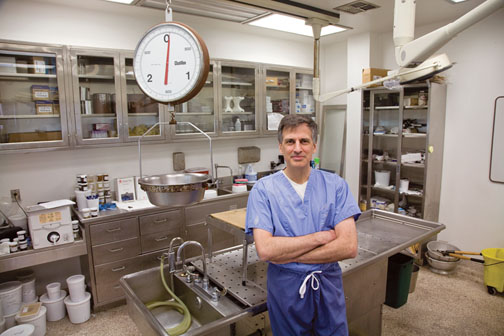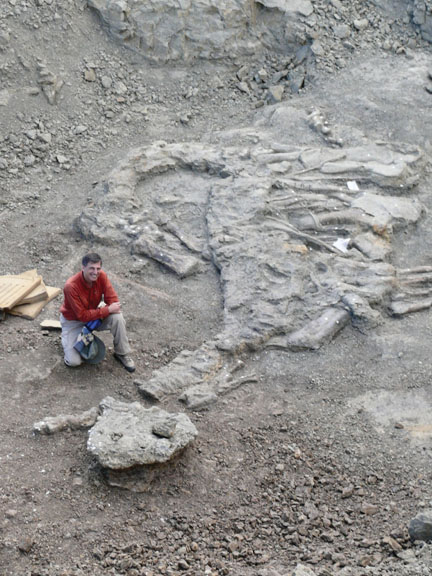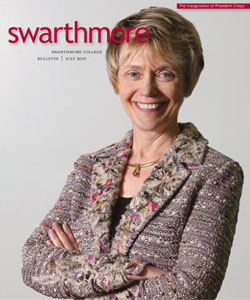Meticulous Intensity
Forensic pathologist and paleontology enthusiast Fredric Hellman ’81 looks for “the mystery of what’s been left out.”

Delaware County Medical Examiner Rick Hellman is one of just three trained forensic pathologist chief medical examiners serving within Pennsylvania’s 67 counties. (The rest are coroners.) His office is also one of the busiest in the state, investigating about 1,300 deaths each year, 30 to 45 homicides, 90 to 100 drug-abuse deaths, and, in 2009, 80 suicides. “Suicide is a horrendous public health problem,” he says. “We worry about swine flu, but this is an epidemic every year.”
THE 45-YEAR-OLD MAN LOOKED QUITE RESTED on the operating table, almost as if he were a character from a cop flick. He was wearing white Nike sneakers, navy blue sweatpants from Old Navy, and a long-sleeved sweatshirt with a Nike logo.
The problem was, the guy was, in fact, dead—one of dozens of dead folks who lie on that operating table every year, ready to be examined by Dr. Fredric “Rick” Hellman. Although it is never a success for a doctor to see a dead person lying on an operating table, that is the only type Hellman gets to see. As the medical examiner in Delaware County, Pa., Hellman is responsible for determining how folks like the guy in the Nike and Old Navy attire breathed their last.
When he’s not wearing scrubs and paper booties and surgical gloves, Hellman is often out searching for other things that are dead and buried, not hours but tens of millions of years before. A dinosaur hunter and fossil finder, he trundles off to Wyoming and Arizona and, especially, to his favorite dino-haunt in remote southwestern North Dakota.
“I don’t know if you can quite connect the two,” says Howard A. Schneiderman Professor of Biology Scott Gilbert, who taught Hellman developmental biology in the early 1980s and later stoked Hellman’s childhood interest in paleontology. “I guess there are evolutionary and biological aspects to fossils and dinosaurs, and if you are interested in that, it may naturally flow that you are interested in forensic medicine,” Gilbert says.
“I would say that it is just because Rick can get interested in anything—and when he does, it becomes a lifelong and impassioned, shall we say, pursuit,” he adds.
Hellman moves around the corpse with a tape recorder in hand. His assistant is taking the clothes off the man’s body with surgical equipment, eventually leaving him naked on the table. The man had apparently died the night before. A relative who lived nearby was supposed to hear from him and did not, so she checked on him and found him lifeless in his apartment.
“I’ve got to think it’s cardiac arrest, but you just never know in this job,” says Hellman, as he notices a crimp in the man’s ear. The crimp, he says, is associated with the loss of elastin, a protein vital to blood pressure in the aorta. The crimp, he says, might be a key to the man’s death by heart attack.
This case would seem like an easy one to an outsider. It is highly unlikely to be a homicide, and so far, it is not even looking like a drug case or one of family neglect. But, really, says Hellman, there are no easy cases in his office.
“Every case has at least one family associated with it,” he says. “When I was young and starting in medicine, I thought I would be a pediatrician, someone who dealt with people mostly in a happy way all the time.”
So for Hellman, each death he investigates comes with a responsibility to ease the family pain around it. He personally calls next of kin, even though he is required only to make a written report. Homicides, yes, they are worse. There is pressure from the cops, pressure from the media, pressure from the politicians, pressure from the community. Even with all this, though, there is the family. Maybe it’s a little more difficult to talk to the family of a homicide victim—or even someone who died under somewhat normal circumstances—rather than the mother of a colicky kid, but it fits into Hellman’s vision of how medicine should be practiced.
“Doctors are not just there to operate. They also have to respond personally. Some people think being a medical examiner is a ghoulish job, but I look at it as a people job, so I actually like talking to the families. It gives solace,” he says.
DELAWARE COUNTY IS THE MOST CROWDED suburban county in Pennsylvania, and about 5,300 people—one percent of the population on average—die there every year. By contrast, there are only about 50 people per square mile in Marmarth, N.D.—and most of the dead things around this town have been that way for, well, ages.
It is in Marmarth where Hellman’s heart can often be found. He is one of the benefactors of the Marmarth Research Foundation, a dinosaur excavation and research station founded by Tyler Lyson ’06, a native of that remote North Dakota village, which just happens to be in one of the world’s prime dinosaur hunting spots, the Hell Creek Formation.
Just about every summer, Hellman heads to Marmarth and spends a week or so doing whatever is needed at the time, whether it is using minuscule dental brushes to carefully sweep dirt away from a fossil, learning how to mount a dinosaur toe, or just roaming around in a pit carefully searching for what might be the next big thing in the far-flung world of paleontology enthusiasts.
“I try to stress on my website that it will be hot and dirty and we work long hours. I want to discourage people who are on the fence about it,” says Lyson, who is currently working on a Ph.D. at Yale University while supervising digs at Marmarth. “But Rick is a very intense individual. He’s passionate about his job and even more passionate about dinosaurs.
“He’s like a kid in a candy store when he’s out here,” says Lyson.
Hellman says he had always been a dinosaur kind of kid, but living in various parts of the country with his government and university scientist parents, he had never actually dug up anything. He kept his passion in check until six or seven years ago, when he and his wife, Holly, went to Jackson Hole, Wyo., for a vacation. While there, he saw a flyer for the Wyoming Dinosaur Center in Thermopolis.
“I said, ‘I really want to do this, because when I was a kid, I always wanted to go to Mongolia and dig up dinosaur eggs’,” says Hellman. “My wife sort of shrugged it off, but I said, ‘No, I really want to do this. Let’s just take a day and drive out there’.”
Holly Hellman, who met her husband when he was working as a medical examiner in Atlanta, where she was a research statistician at the Centers for Disease Control, says she has always been attracted to her husband’s intense nature.
“That’s his personality. When he takes an interest in something, he needs to gather all the information on it,” Holly Hellman says. “There are so many aspects to paleontology, it’s been keeping him busy for a long time.”
Burkhart Pohl, the founder of the Wyoming Dinosaur Center, encouraged Hellman to go to the annual mineral and fossil show in Tucson, Ariz., where Hellman bought his first specimens. He showed them to an old Swarthmore friend, college greenhouse manager Bill Pinder ’78, who told him about Lyson, then a sophomore but already an acknowledged expert in paleontology.
“Tyler thought the fossil was pretty cool. We struck up a friendship, despite our difference in age,” said Hellman, who went out to Marmarth the next summer, just as Lyson was excavating what is probably his most prized find—a mummified hadrosaur he had first seen when he was in high school. The duck-billed dino—nicknamed Dakota—was unusual in that it had fossilized skin and muscle as well as bones. When excavated, they found even more hadrosaur bones.
For Hellman, it was like being in the California Gold Rush. He was hooked. He bought an old house on the site, which he rented to Lyson for a dollar a year, so that Lyson’s Marmarth Foundation could have a headquarters and a laboratory. It also gives Hellman reason to indulge in his avocation.
“Life is short,” says Hellman, in a rare relaxed moment with a hot chocolate at the Swarthmore Dunkin’ Donuts. “You’ve got to have fun. So this is one of the things I like to do. “And my wife puts up with it,” he says with a modest chuckle.

“He’s like a kid in a candy store when he’s out here,” says Tyler Lyson, founder of the Marmarth Research Foundation. “Everyone finds fossils out there, but Rick runs around all day with such great joy, and it’s hard to get him to come in at night.”
“TOENAILS ARE WELL CARED FOR AND NEATLY TRIMMED,” Hellman says into his tape recorder as he walks around the now-naked body. “There are no significant injuries observed. Penis is circumcised. Fingernails trimmed.”
Just then, a little liquid comes out of the dead man’s mouth. “Fluid vomitus,” he says into the tape recorder and sighs. “Good things and bad. You have to be complete because you just never know.”
Hellman credits both his meticulousness and intensity to his parents, immigrants from Europe who met as graduate students in the sciences at the University of Michigan.
“My dad was born in Germany, which was not a good place to be born in 1931 if you were Jewish,” says Hellman. His father survived in concentration camps for a couple of years and then was smuggled out of Europe. His mother came a little more safely to the United States from her native Greece. His friend Scott Gilbert believes that Hellman’s father’s concentration camp experience informs, in part, Hellman’s attitude toward his job. “He doesn’t want to see people getting away with murder. He will do whatever he can to find out what caused a death,” says Gilbert. Hellman does not disagree.
“There is no question that it played a role in my decision to go into medicine, at the very least,” says Hellman, who also served for a time in the Army after medical school.
“Between my service in the military and the government, I often have thought about giving power to the powerless. If a relative has been persecuted, you certainly have a tendency to want to exercise justice.”
He says his parents were ecstatic that he became a doctor (“They were Jewish parents after all,” he says with a laugh.), but his first obsession in college, he says, was art. He painted—first scenes, then figures. His painting got him interested in how bones, muscles, body parts got to be the way they looked. He took Gilbert’s developmental biology course, which sparked his interest in disease and its evolution. He worked in the pulmonary pathology lab at Einstein Hospital in North Philadelphia, but searching for disease wasn’t enough, so he went through a three-year medical curriculum at Eastern Virginia Medical School, initially to become a pediatrician, before deciding to concentrate on training in pathology at the Hospital of the University of Pennsylvania.
“Rick is always looking for the mystery of what’s been left out,” says Gilbert. “The eye does that in painting, and it certainly does that in forensics.”
Hellman’s bubbling polymathic quest for knowledge started early, says Maria Lynch, who taught him eighth-grade science back in Rockville, Md., and has kept in touch with Hellman ever since.
“He has always had this infectious joy of discovery,” says Lynch. “He has always been, even as an eighth-grader, happy to learn. What does it do? Where does it come from? His interests were never narrow. It sounds like a cliché, but he loved people, too, so that is a rare combination.”
But when he went into forensics, that meticulous science of finding, basically, how crime is committed, Lynch was baffled.
“‘You are so good with people,’ I told him. ‘Why do you want to deal with the dead?’” she says. “His answer was that those close to the dead person need to know how they got that way and be told so with compassion.”
HELLMAN CAREFULLY TURNS THE BODY ON its right side and takes note of a tattoo on its upper back. “Dusky discoloration of the head,” he says laconically into the tape recorder. “Five-eighths-inch scar on the neck,” he says as he takes out a small ruler to measure. “Seems as if gagging occurred. Could be a flu,” he says later.
Half the deaths Hellman sees are natural, and presumably noncontroversial. But then there are the 30 to 45 homicides a year that occur in Delaware County and the 90 to 100 deaths that are drug-abuse related. Even those do not wrench Hellman as much as the suicides, and 2009 was a bad year. In an average year, there are 56 to 58 suicides in the county, but there were 80 in 2009.
“Suicide is a horrendous public health problem,” says Hellman, who chairs or is part of several public health and suicide prevention and awareness committees and societies, locally and nationwide. “I take special care when I talk to families who suffer a suicide. There is a stigma and, unfortunately, it is hard to get around it.”
Hellman rattles off lots of statistics about suicide—60 percent of all suicides are by firearms, while overdoses are frequently seen in middle-aged women. Since about two-thirds of suicides are impulsive, getting firearms out of the reach of potential suicide victims would be a huge deterrent.
“Unfortunately, when I go into schools or public forums, I may be the first person to talk about suicide,” he says. “But 80 this past year, that’s nearly two a week in this small county. We worry about swine flu, but this is an epidemic every year.”
David McKeighan, the executive director of the Delaware County Medical Society, of which Hellman is president-elect, says that Hellman is vigilant in talking to groups and other doctors about gun violence, especially in how it relates to suicide and young people.
“We’re interested in prevention and ‘postvention,’ if you will,” said McKeighan. “He goes out constantly to make sure people know about the links—or sometimes the lack of links—between depression and suicide.”
Hellman says he rarely brings his work home, to which Holly assents. Hellman has a 17-year-old daughter from a former marriage, who lives in Swarthmore with them, and three younger children with Holly.
“I think they know what he does and don’t really think it’s creepy or weird,” Holly says. When he’s on the news because of a homicide or odd case, it stays in the office.
Hellman has also moved into academia, helping to set up the Drexel University Medical School program in forensic science. The first of its kind in a medical school, it offers a master’s degree to people like biologists, police officers, and even FBI investigators.
“There is a wide variety of forensics, and a lot of it is actually fun,” he says. “There’s forensic botany—what plants may have affected a crime scene—and even forensic entomology. There are insects all over forensic scenes. and I guess I can use that with the dinosaurs. Lots of bugs in North Dakota.”
While Hellman is always itching to go to North Dakota or some other paleontology site, he acknowledges that he gets to go because he trades off vacations with Holly.
“Holly’s a big outdoorsy type. Her vacation ideas are pretty good,” he said. They went to Peru recently—not on the tourist trail, but hiking and climbing and taking local buses to the mountains and the rainforest. They’ve also been to the Galápagos Islands. Then he gets his week or two in the fossil pits.
“When you excavate something that’s 65 million years old, you start thinking more about how quickly a human life goes,” says Hellman. “I don’t know if it’s possible to relate my job and my passion for dinosaurs, but if you can, it is that life is precious and worth looking at in every way possible.”
New Jersey-based writer Robert Strauss says he left the operating room before the gory part started. The man had died from sudden cardiac death due to coronary artery disease.
 Email This Page
Email This Page